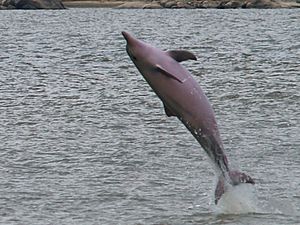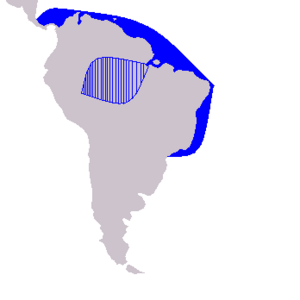Tucuxi facts for kids
Quick facts for kids Tucuxi |
|
|---|---|
 |
|
| Jumping tucuxi in the Orinoco river | |
 |
|
| Size compared to an average human | |
| Conservation status | |
| Scientific classification | |
| Genus: |
Sotalia
|
| Species: |
fluviatilis
|
 |
|
| Range of the tucuxi (inland–hatched pattern) and costero (coastal–solid pattern) | |
The tucuxi (Sotalia fluviatilis) is a type of freshwater dolphin. You can find it in the rivers of the Amazon basin. In Peru, people sometimes call it bufeo gris or bufeo negro. The name tucuxi comes from the Tupi language word tuchuchi-ana.
Even though tucuxis live in the same areas as 'true' river dolphins, like the boto, they are not closely related. Instead, tucuxis belong to the oceanic dolphin family, called Delphinidae.
Physically, the tucuxi looks a lot like bottlenose dolphins. However, they are different enough to be in their own separate genus, Sotalia. The Guiana dolphin (Sotalia guianensis) is a related dolphin. It lives in coastal areas and river mouths. For a long time, scientists thought it was the same as the tucuxi. But now, they know it is a different species.
Contents
What Does a Tucuxi Look Like?
The tucuxi often looks similar to a bottlenose dolphin. But it is usually smaller, growing to about 1.5 meters (4.9 feet) long. Its back and sides are light to bluish-grey. The belly area is much lighter, often appearing pinkish. Scientists think this pink color might come from increased blood flow.
The fin on its back is usually slightly hooked. The dolphin's snout, called a beak, is clear and not too long. Tucuxis have between 26 and 36 pairs of teeth in both their upper and lower jaws. They also have one of the largest known encephalization quotients among mammals. This means their brain size is very large compared to their body size.
Where Do Tucuxis Live?
Tucuxis live along most of the Amazon River and many of its smaller rivers. You can find them in countries like Venezuela, Brazil, Peru, Ecuador, and southeastern Colombia. Some tucuxis have also been seen in the Orinoco River further north. However, it is not always clear if these are tucuxis or costero dolphins.
Recently, scientists found that tucuxis live in an even larger area. This includes the northeast part of Brazil, like the state of Amapa. This means they live in more river systems than just the Amazon basin. Tucuxis only live in freshwater habitats.
What Do Tucuxis Eat?
Tucuxis hunt for food in small, close groups. They often chase fish very quickly just below the water's surface. Sometimes, the fish even jump out of the water to escape! Scientists know that tucuxis eat about 30 different kinds of fish. Some of these fish live in calm lakes and channels. Others live in fast-flowing rivers.
How Do Tucuxis Behave?
Tucuxis live in small groups of about 10 to 15 dolphins. They swim very close together. This suggests they have a strong social structure. Tucuxis are very active. They might jump completely out of the water, which is called breaching. They can also do somersaults, spy-hop (stick their head out of the water), or splash their tails. However, they usually do not come close to boats.
Tucuxis have been seen feeding with other river dolphins. They eat many different types of fish. Studies show that tucuxis can live for up to 35 years. The oldest known tucuxi was 36 years old.
What Threats Do Tucuxis Face?
Traditional Uses
Some local traditions use parts of the tucuxi. For example, the oil and fat from their skin might be used as an ointment. People believe this ointment can help with certain illnesses. The teeth are sometimes ground into a powder. This powder is thought to help with breathing problems. The number of dolphins used for these purposes is not known. So, it is hard to say how much it affects tucuxi populations.
Fishing Activities
Tucuxi dolphins often interact with fishing activities in the Western Brazilian Amazon. Tucuxis hunt for fish that swim in schools. These fish are also important for commercial fishing in the area. Tucuxis can easily get caught in commercial fishing nets, especially in the lower Japurá River. Sadly, the bodies of dolphins caught by accident or on purpose are sometimes used as bait for piracatinga fish.
Habitat Problems
Human activities have greatly affected the places where tucuxis live. For example, building hydroelectric dams can separate dolphin groups. This makes it harder for them to move freely. Pollution from human activities also makes their habitat less healthy. This increases the chance for tucuxis to eat heavy metals, which can harm them.
How Are Tucuxis Protected?
The tucuxi lives only in the areas mentioned above. We do not have exact numbers for their population. However, they are generally common. A big problem for them is fishing nets. People have also reported hunting tucuxis for food in the Amazon basin. Pollution is another major worry, especially mercury poisoning of water from gold mining.
The IUCN also says that dams breaking up their habitat is a threat. More studies are needed to understand this fully.
Tucuxis usually do not stay healthy or happy in captivity. A few tucuxis were kept in aquariums in Europe. But the last one, named "Paco," died in 2009 at the Zoo in Münster, Germany.
The tucuxi is listed in Appendix II of the Convention on the Conservation of Migratory Species of Wild Animals (CMS). This means it needs international help to protect it.
See also
 In Spanish: Tucuxi para niños
In Spanish: Tucuxi para niños
- List of cetaceans
- Environmental issues in Brazil



